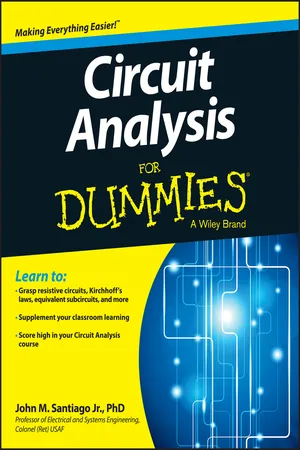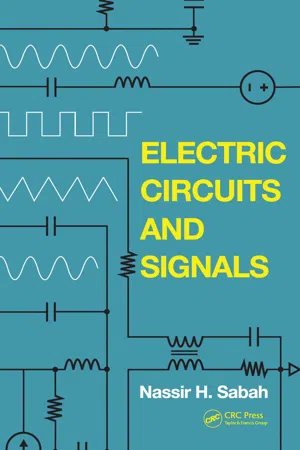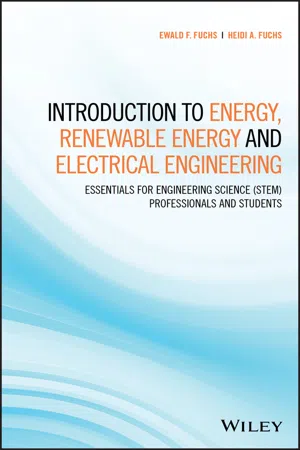Physics
Second Order Circuits
Second order circuits are electrical circuits that contain second-order differential equations. These circuits typically involve energy storage elements such as capacitors and inductors. They exhibit more complex behavior compared to first-order circuits, with characteristics such as resonance, oscillation, and transient response. Analysis of second order circuits often involves solving differential equations and understanding the behavior of the circuit over time.
Written by Perlego with AI-assistance
Related key terms
Related key terms
1 of 4
Related key terms
1 of 3
4 Key excerpts on "Second Order Circuits"
- eBook - ePub
- John Santiago(Author)
- 2013(Publication Date)
- For Dummies(Publisher)
Chapter 14 .)If your head is cloudy on the calculus, check out a diff EQ textbook or pick up a copy of Differential Equations For Dummies by Steven Holzner (Wiley) for a refresher.Solving First-Order Circuits with Diff EQTo find out what’s happening in circuits with capacitors, inductors, and resistors, you need differential equations. Why? Because generating current through a capacitor requires a change in voltage, and generating voltage across an inductor requires a change in current. Differential equations take the rate of change into account.You have a first-order circuit when a first-order differential equation describes the circuit. A resistor and capacitor connected in series (an RC series circuit ) is one example of a first-order circuit. A capacitor’s version of Ohm’s law with capacitance C is described by a first-order derivative:Another first-order circuit is a resistor and inductor connected in parallel (an RL parallel circuit ). An inductor with inductance value L has an i -v relationship also expressed by a first-order derivative:Because the capacitance C and inductance L are constant and connected to a constant resistor, circuits with these devices lead to differential equations that have constant coefficients.So when analyzing a circuit with an inductor or a capacitor with a resistor driven by an input source, you have a first-order differential equation. Both types of first-order circuits have only one energy storage device and one resistor, which converts electricity to heat. To get a complete solution to the first-order differential equation, you need to know a circuit’s initial condition. An initial condition is simply the initial state of the circuit, such as the inductor current or the capacitor voltage at time t - Ed Lipiansky(Author)
- 2012(Publication Date)
- Wiley-IEEE Press(Publisher)
dB. Frequencies two orders of magnitude smaller than the cutoff are attenuated 40 dB. This goes on at a rate of 20 dB attenuation per decade. The phase of all frequencies at least one order of magnitude lower than fThe same first-order RC circuit performs time differentiation of the signals that have frequencies at least one order of magnitude lower than than the filter cutoff frequency.0 experience an approximate +90-degree phase shift.A practical limitation of the differentiator implemented with a first-order RC HPF circuit is that the differentiated output signal is attenuated, while other higher frequency signals above the cutoff frequency pass through the filter practically unaltered. We will see how to overcome these problems using an operational amplifier in Chapter5 .4.4 SECOND-ORDER CIRCUITS
Second-order circuits are described by second-order ordinary differential equations with constant coefficients. Refer to Equation (4.66) to observe a second-order circuit differential equation:(4.66)In Equation (4.66) , f (t ) usually is i (t ) or v (t ), respectively current or voltage varying with respect to time. a 0 , a 1 , and a 2 are the constant coefficients, typically real numbers. t is time, the independent variable.Equation (4.66) may be equated to zero or to a constant or to a function of time. Equation (4.66) equates the differential equation to zero, thus Equation (4.67) :(4.67)The differential equation of Equation (4.67) describes a second-order circuit without any external excitation. When Equation (4.66) is equated to a constant, it is usually when the second-order circuit is excited by a step. From now on, we will refer to a circuit described by a differential equation of the form given by Equation (4.66)- eBook - ePub
- Nassir H. Sabah(Author)
- 2017(Publication Date)
- CRC Press(Publisher)
13 Switched Circuits Overview After considering the impulse responses of first-order and second-order circuits in the preceding chapter, we turn our attention in this chapter to switched circuits; that is, circuits in which the movement of a switch applies an input to the circuit or changes the circuit configuration. A practically important case is the application of a step input to a circuit. The responses of prototypical first-order and second-order circuits to a step input are analyzed in this chapter and related to the impulse response. We begin by answering a fundamental question as to the need for having a transient component in the response of a circuit. Considering first-order circuits, it turns out that a general procedure can be readily developed that expresses the time variation of any variable in the circuit in terms of the initial value of the variable, its final value, and the effective time constant. When it comes to second-order circuits, the situation is more complicated. The general case of switched circuits that have relatively complicated connections of resistors, inductors, and capacitors, and which may include linear transformers and dependent sources, is best handled using the Laplace transform, as will be discussed in Chapter 15. The discussion is therefore restricted to prototypical second-order circuits that can be reduced to series or parallel connections of resistors, inductors, and capacitors - eBook - ePub
Introduction to Energy, Renewable Energy and Electrical Engineering
Essentials for Engineering Science (STEM) Professionals and Students
- Ewald F. Fuchs, Heidi A. Fuchs(Authors)
- 2020(Publication Date)
- Wiley(Publisher)
3 DC Circuit Transient AnalysisIn this chapter, we examine the behavior of a DC network as a function of time after a sudden change in the network occurs due to opening or closing of switches. The DC network may contain resistors, inductors, and capacitors. First‐ and second‐order ordinary differential equations will be analytically and numerically solved by well‐known solution techniques and numerical methods such as PSPICE [1 –4 ], MATLAB/Simulink [5 ], and Mathematica [6 ]. Note that there are standard resistor [7 ], capacitor [8 ], and inductor [9 ] values. In electric circuit designs, any (certain) resistor, capacitor, and inductor values might be required based on the desired design performance. These certain (e.g. resistance) values are not necessarily manufactured and sold, simplifying the manufacturing process of resistors: only well‐defined resistance values of resistors are manufactured. For example, a design requires the resistance value of 25 Ω; then a series combination of two resistors with standard resistance values of 10 and 15 Ω must be used because 10 Ω + 15 Ω = 25 Ω. For a 6 Ω resistor, the two resistors with standard values 10 and 15 Ω can be connected in parallel such that .3.1 Capacitors
3.1.1 Energy Stored in a Capacitor
Ideal lossless (with no losses) capacitors consist of two conducting plates separated by a nonconducting, or dielectric, material. The simplest capacitor consists of two parallel plates as shown in Figure 3.1 . Note the capacitor is the name of a device having the capacitance C. Any conducting or nonconducting material – which is electrically isolated – can be charged with endowed (see Chapter 1 , Appendix 1.B) electrons and has the property of capacitance C
Index pages curate the most relevant extracts from our library of academic textbooks. They’ve been created using an in-house natural language model (NLM), each adding context and meaning to key research topics.
Explore more topic indexes
Explore more topic indexes
1 of 6
Explore more topic indexes
1 of 4



